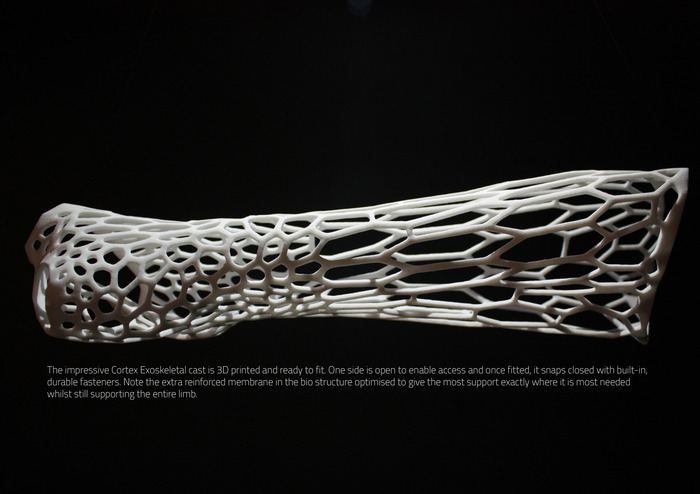3D Printing the Cast of the Future

The next generation of casts could include the Cortex. Courtesy of Jake Evill.
Latest News
July 1, 2013
If you’ve ever broken a limb you, no doubt, have unpleasant memories surrounding that unwieldy, heavy and itchy plaster cocoon that enclosed your arm or leg. I have personal experience with casts as a result of a poorly conceived attempt to recreate the flight of Superman when I was in grade school. Bits of various object ended up lodged in the thing from attempts to scratch beneath it, and I actually managed to grind off (it’s amazing how fast a merry-go-round can go) enough of the cast that it had to be repaired by my doctor.
Like many other items, the future of the cast may well be shaped by additive manufacturing (AM). The Cortex is an idea hatched by Jake Evill (maybe the best name ever if he goes for a doctorate) that uses 3D printing to form an exoskeleton around breaks. The Cortex is lighter than traditional casts and, best of all, has enough holes in it that you could actually scratch beneath it without fear of injuring yourself with something pointy.
From Evill’s web page:
After many centuries of splints and cumbersome plaster casts that have been the itchy and smelly bane of millions of children, adults and the aged alike, the world over, we at last bring fracture support into the 21st century. The Cortex exoskeletal cast provides a highly technical and trauma zone localized support system that is fully ventilated, super light, shower friendly, hygienic, recyclable and stylish.
Fitting the Cortex to a patient uses an X-ray to determine the exact location of the break, followed by a 3D scan of the limb in question. Information from the X-ray and scan are fed into a computer, which crunches the data to determine the best possible structural design for the Cortex to provide support for the break. A 3D printer then builds the über-cast, complete with built-in fasteners.
Not only would the Cortex be lighter and less annoying to wear, shaping each cast to a specific patient would reduce medical waste. The slimmer design would more easily fit under clothing, and doctors could even add some flourishes to the cast for those inclined to fashion.
Sadly, I can’t find a video related to the Cortex, so below you’ll find a clip about how 3D printing helped build Iron Man’s suit. I’m sure the suit keeps Tony Stark from breaking something.
Sources: SlashGear, Jake Evill
Subscribe to our FREE magazine, FREE email newsletters or both!
Latest News
About the Author
John NewmanJohn Newman is a Digital Engineering contributor who focuses on 3D printing. Contact him via [email protected] and read his posts on Rapid Ready Technology.
Follow DE






